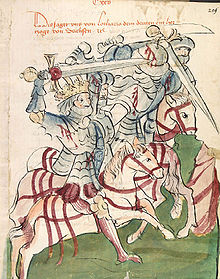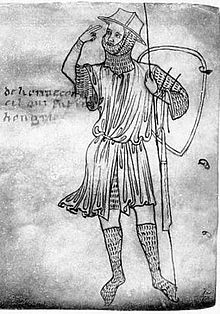Poleyn: Difference between revisions
m clean up, replaced: century manuscript → -century manuscript using AWB |
No edit summary |
||
| Line 1: | Line 1: | ||
[[Image:Ludwig III in der Schlacht von Kulm.jpg|right|thumb|220px|Ludwig III wearing gothic armor with prominent poleyns, from a fifteenth-century manuscript.]] |
[[Image:Ludwig III in der Schlacht von Kulm.jpg|right|thumb|220px|Ludwig III wearing gothic armor with prominent poleyns, from a fifteenth-century manuscript.]] |
||
The '''poleyn''' was a component of [[Medieval]] and [[Renaissance]] armor that protected the knee. During the [[Transitional armour|transition]] from [[chainmail|mail]] armor to [[plate armor]], this was among the earliest plate components to develop. They first appeared in the mid-thirteenth century and remained in use until the early seventeenth century when firearms made them obsolete |
The '''poleyn''' was a component of [[Medieval]] and [[Renaissance]] armor that protected the knee. During the [[Transitional armour|transition]] from [[chainmail|mail]] armor to [[plate armor]], this was among the earliest plate components to develop. They first appeared in the mid-thirteenth century and remained in use until the early seventeenth century when firearms made them obsolete. |
||
The specifics of poleyn design varied considerably over that period. The earliest poleyns were strapped over mail [[chausses]]. Late fourteenth century and early fifteenth century poleyns usually attached to padded leggings with leather buckles and incorporated [[gousset]]s. During the fifteenth century poleyns developed an articulated construction that attached to the [[cuisses]] and [[schynbalds]] or [[greave]]s. A characteristic of late fifteenth century [[gothic armor]] was a projection that guarded the side of the knee. |
The specifics of poleyn design varied considerably over that period. The earliest poleyns were strapped over mail [[chausses]]. Late fourteenth century and early fifteenth century poleyns usually attached to padded leggings with leather buckles and incorporated [[gousset]]s. During the fifteenth century poleyns developed an articulated construction that attached to the [[cuisses]] and [[schynbalds]] or [[greave]]s. A characteristic of late fifteenth century [[gothic armor]] was a projection that guarded the side of the knee. |
||
Revision as of 19:44, 19 July 2013

The poleyn was a component of Medieval and Renaissance armor that protected the knee. During the transition from mail armor to plate armor, this was among the earliest plate components to develop. They first appeared in the mid-thirteenth century and remained in use until the early seventeenth century when firearms made them obsolete.
The specifics of poleyn design varied considerably over that period. The earliest poleyns were strapped over mail chausses. Late fourteenth century and early fifteenth century poleyns usually attached to padded leggings with leather buckles and incorporated goussets. During the fifteenth century poleyns developed an articulated construction that attached to the cuisses and schynbalds or greaves. A characteristic of late fifteenth century gothic armor was a projection that guarded the side of the knee.


See also
External links
- The Poleyn instructions for creating reproduction sixteenth century poleyns
- Leg Harness (1400 - 1620) description of historic developments in leg armor

